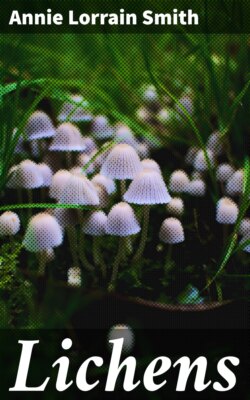Читать книгу Lichens - Annie Lorrain Smith - Страница 20
На сайте Литреса книга снята с продажи.
B. Gonidia contrasted with Algae
ОглавлениеIn describing the gonidia of the Graphideae Wallroth[159] had pointed out their affinity with the filaments of Chroolepus (Trentepohlia) umbrina. He considered these and other green algae when growing loose on the trunks of trees to be but “unfortunate brood-cells” which had become free and, though capable of growth and increase, were unable to form again a lichen plant.
Further observations on gonidia were made by E. Fries[160]: he found that the green cells escaped from the lichen matrix and produced new individuals; and also that the whole thallus in moist localities might become dissolved into the alga known as Protococcus viridis; but, he continues, “though these Protococcus cells multiplied exceedingly, they never could rise again to the perfect lichen.” Kützing[161], in a later account of Protococcus viridis, also recognized its affinity with lichens; he stated that he could testify from observation that, according to the amount of moisture present, it would develop, either in excessive moisture to a filamentous alga, or in drier conditions “to lichens such as Lecanora subfusca or Xanthoria parietina.”
Fig. 3. Coenogonium ebeneum A. L. Sm. Tip of lichen filament, the alga overgrown by dark fungal hyphae × 600.
A British botanist, G. H. K. Thwaites[162], at one time superintendent of the botanical garden at Peradeniya in Ceylon, published a notable paper on lichen gonidia in which he pointed out that as in Collema the green constituents of the thallus resembled the chains of Nostoc, so in the non-gelatinous lichens, the green globose cells were comparable or identical with Pleurococcus, and Thwaites further observed that they increased by division within the lichen thallus. He insisted too that in no instance were gonidia reproductive organs: they were essential component parts of the vegetative body and necessary to the life of the plant. In a further paper on Chroolepus ebeneus Ag., a plant consisting of slender dark-coloured felted filaments, he described these filaments as being composed of a central strand which closely resembled the alga Chroolepus, and of a surrounding sheath of dark-coloured cells (Fig. 3): “occasionally,” he writes, “the internal filament protrudes beyond the investing sheath, and may then be seen to consist of oblong cells containing the peculiar reddish oily-looking endochrome of Chroolepus.” Thwaites placed this puzzling plant in a new genus, Cystocoleus, at the same time pointing out its affinity with the lichen genus Coenogonium. The plant is now known as Coenogonium ebeneum. Thwaites was on the threshold of the discovery as to the true nature of the relationship between the central filament and the investing sheath, but he failed to take the next forward step.
Very shortly after, Von Flotow[163] published his views on some other lichen gonidia. He had come to the conclusion that the various species of the alga, Gloeocapsa, so frequently found in damp places, among mosses and lichens, were merely growth stages of the gonidia of Ephebe pubescens, and bore the same relation to Ephebe as did Lepra viridis (Protococcus) to Parmelia. The gonidium of Ephebe is the gelatinous filamentous blue-green alga Stigonema (Fig. 4), and the separate cells are not unlike those of Gloeocapsa. Flotow had also demonstrated that the same type of gonidium was enclosed in the cephalodia of Stereocaulon. Sachs[164], too, gave evidence as to the close connection between Nostoc and Collema. He had observed numerous small clumps of the alga growing in proximity to equally abundant thalli of Collema, with every stage of development represented from one to the other. He found cases where the gelatinous coils of Nostoc chains were penetrated by fine colourless filaments “as if invaded by a parasitic fungus.” Later these threads were seen to be attached to some cell of the Nostoc trichome. Sachs concluded, however, from very careful examination at the time, that the colourless filaments were produced by the green cells. As growth proceeded, the coloured Nostoc chains became massed towards the upper surface, while the colourless filaments tended to occupy the lower part of the thallus. He calculated that during the summer season the metamorphosis from Nostoc to a fertile Collema thallus took from three to four months. He judged that in favourable conditions the change would inevitably take place, though if there should be too great moisture no Collema would be formed. His study of Cladonia was less successful as he mistook some colonies of Gloeocapsa for a growth condition of Cladonia gonidia, an error corrected later by Itzigsohn[165].
Fig. 4. Ephebe pubescens Nyl. Tip of lichen filament × 600.
But before this date Itzigsohn[166] had published a paper setting forth his views on thallus formation, which marked a distinct advance. He did not hazard any theory as to the origin of gonidia, but he had observed spermatia growing, much as did the cells of Oscillaria: by increase in length, and, by subsequent branching, filaments were formed which surrounded the green cells; these latter had meanwhile multiplied by repeated division till finally a complete thallus was built up, the filamentous tissue being derived from the spermatia, while the green layer came from the original gonidium. In contrasting the development with that of Collema, he represents Nostoc as a sterile product of a lichen and, like the gonidia of other lichens, only able to form a lichen thallus when it encounters the fructifying spermatia.
Braxton Hicks[167], a London doctor, some time later, made experiments with Chroococcus algae which grew in plenty on the bark of trees, and followed their development into a lichen thallus. He further claimed to have observed a Chlorococcus, which was associated with a Cladonia, divide and form a Palmella stage.
